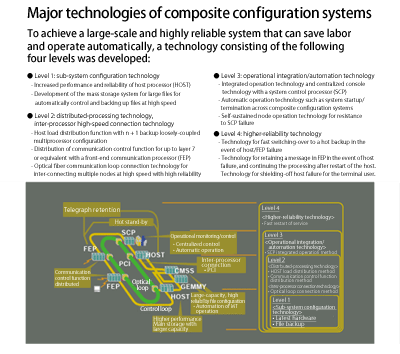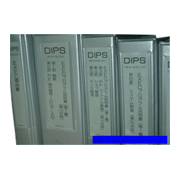- ・106-20OS
- In the 1980s, the demand for computer systems with higher processing capability was increasing, and their system scales were also growing as the information-oriented society matured. Meanwhile, there was growing demand for higher reliability, simplified operability, and expandability to respond to increased and additional operations as well as the demand for better system capabilities and larger scale. As for DIPS, to meet these requirements, large-scale systems with distributed system configurations were enabled by developing the DIPS Computer Complex Configuration System, where the host computers (HOST: DIPS-11/5E series) and the front-end communication control processors (FEP: CCP-IIE series) were interconnected by using a high-performance optical-fiber communication loop. The DIPS computer complex configuration system enabled the operation of a group of these processor nodes to be centralized and significantly automated.
The functions developed for achieving the complex configuration system included hardware consisting of the processor-node communication equipment using an optical fiber communication loop and the system control processors that monitor and control the whole complex configuration system. As for software, the DIPS-11/5E series included automated operation of each node, automated switchover to the stand-by host processor in the event of host failure, automated processing suspension and resumption functions for messages within the FEPs during/after host failure, and centralized and automated operation management functions.
The largest-scale functional additions and reorganizations for the DIPS-OS series were made in supporting the new types of hardware, including the new small-type host computers, a large secondary storage with automatic media-storing mechanism (CMSS), optical disc, semiconductor disc, multi-processor control (max 4 unit), duplex disc control, high-performance data channel control, and hierarchical file control.
The 106-20OS was deployed into a large number of large-scale systems, such as the Postal Saving System of The Ministry of Posts and Telecommunications, the Japanese Bankers Association’s new fund transfer and remittance system, and the Transportation Ministry’s car registration management system.
- ・106-21OS
- The 106-21OS was the final release of the DIPS-OS series. In the planning of 106-21OS, there were concepts for achieving a new system with higher performance and reliability. However, the decision was made to shift from in-house to a multi-vendor system based on an off-the-shelf computer instead of continuing to develop its own OS and hardware. As a result, 106-21OS was developed as the final release of the DIPS-OS series; it extended the address space for the DIPS-11/5EX mid-to-large host series, the CCP-IEX/IIEX front-end communication control processors (FEP: Front End Processor), and the DIPS-V40SX/EX and 5EX small host series. For hardware, it supported the shared extended storage functions and the optical disc controls for large secondary storages with automated media storing mechanisms.
- Reference material
- The figure shows the major technologies of complex configuration systems for computers.



